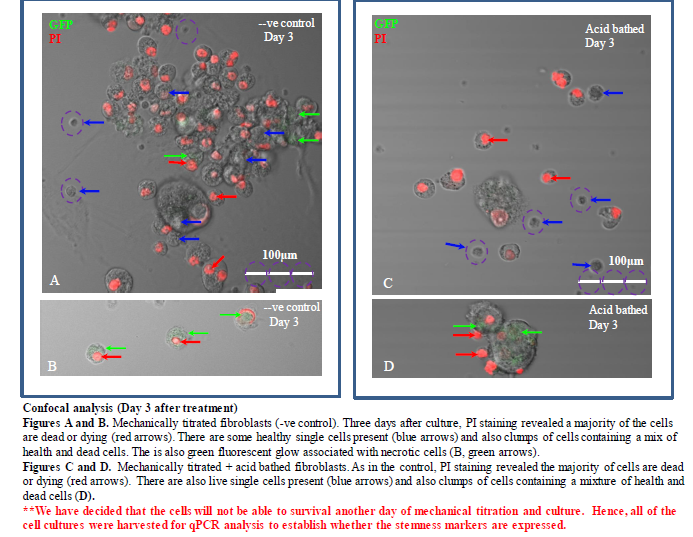LA Times reports that just hours after Japanese investigators announced findings of fabrication and misconduct in a highly criticized “acid bath” stem cell study, scientists in Hong Kong said they had partly succeeded in reproducing the controversial experiment, but without acid.
Kenneth Ka-Ho Lee, a professor and stem cell scientist at the Chinese University of Hong Kong, said Tuesday that he was shocked speechless when he and colleagues managed to create cells that appeared similar to the so-called STAP cells described in the much-discredited research papers.
Lee initially attempted to reprogram mouse blood cells into pluripotent stem cells — cells capable of transforming into most any other type of cell — using the original study’s protocol, but failed.
When one of the original study’s authors, Dr. Charles Vacanti of Harvard affiliated Brigham and Women’s Hospital in Boston, released another protocol for the experiment, Lee said he would try that one as well.
The Vacanti recipe for “stimulus triggered acquisition of pluripotency,” or STAP cells, calls for soaking the cells in an acid bath, but also passing them through extremely narrow glass tubes, or pipettes. (The diameter of the narrowest glass tubes is about 2.5 times the size of the cells themselves.)
Kenneth Ka-Ho Lee and his colleagues are reporting and discussing their results at Researchgate.ent
Kenneth failed to produce the so-called STAP-cells following the methods described in a detailed protocol that was released by the authors of the study led by Haruko Obokata in early March. Kenneth posted the results from this trial with Open Review on March 13, 2014.
Since then, more doubts on the study’s validity have arisen. Charles Vacanti, another co-author of the Nature study from Harvard University, released a different version of the protocol. This new method was the focus of Kenneth’s second attempt to reproduce the study, which he live-blogged about on ResearchGate.
On April 1, at 5:30 pm Hong Kong time, Kenneth posted results. They may suggest that STAP works, and if so, the trick doesn’t seem to be the acid.
The Vacanti protocol required placing a lot of stress on the cells. So much, in fact, that during the first three days of the experiment Kenneth reported rapid cell death to the point where he decided to cut the experiment short. He feared that he wouldn’t have had enough cells left to examine for signs of pluripotency if he had carried on with the rather harsh procedure another day.
In addition to being bathed in acid, the Vacanti protocol said to manually triturate the cells using pipettes with decreasing lumen twice a day. Kenneth’s results seem to suggest that this is what might have reprogrammed them to pluripotency.
April 3rd Kenneth discounts the results
Kenneth Ka-Ho Lee · The Chinese University of Hong Kong
Thank you all [other researchers at Researchget.net] for your excellent suggestions on improving the data. Personally, I don’t think STAP cells exist and it will be a waste of manpower and research funding to carry on with this experiment any further.
I think this live-blogging is a good and bad idea:
Good in the sense that it will stimulate interest in the scientific community, so helping to draw younger scientists into the stem cell field.
Bad in the sense that you don’t have the time to think and carefully assess the data properly – as everyone expect you to post the results as soon as it is generated. E.g. In my case a 10 folds increase in Oct4 and Nanog expression is definitely not sufficient and we need to see at least 100 folds as in my previous post. And for Sox2 it is only at 2 fold increase – which is even worst.
I will no longer blog on this page any more. I want to get back to doing my own science interest.
Anyone want to collaborate with me to look at the function of the BRE gene which is a component of the BRCA1 and BRISC complex?
If you liked this article, please give it a quick review on ycombinator or StumbleUpon. Thanks

Brian Wang is a Futurist Thought Leader and a popular Science blogger with 1 million readers per month. His blog Nextbigfuture.com is ranked #1 Science News Blog. It covers many disruptive technology and trends including Space, Robotics, Artificial Intelligence, Medicine, Anti-aging Biotechnology, and Nanotechnology.
Known for identifying cutting edge technologies, he is currently a Co-Founder of a startup and fundraiser for high potential early-stage companies. He is the Head of Research for Allocations for deep technology investments and an Angel Investor at Space Angels.
A frequent speaker at corporations, he has been a TEDx speaker, a Singularity University speaker and guest at numerous interviews for radio and podcasts. He is open to public speaking and advising engagements.


